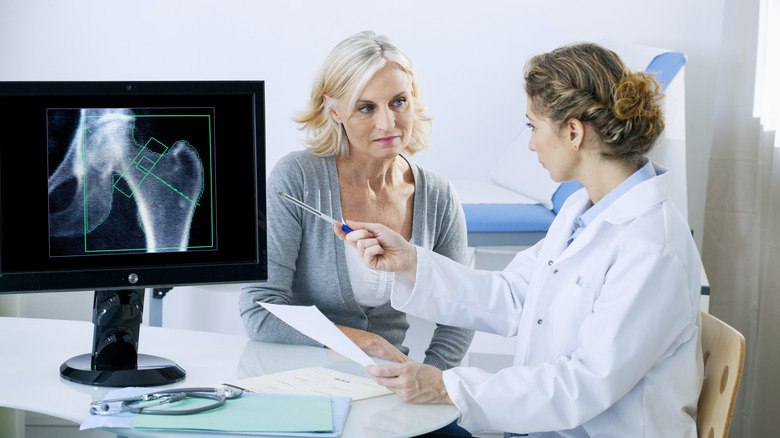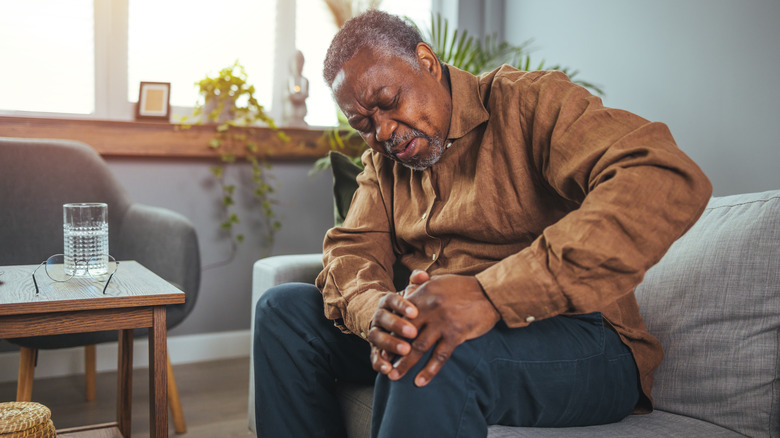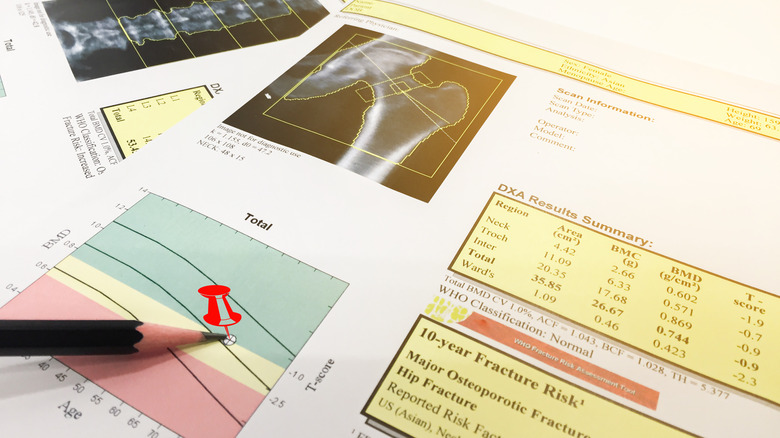What To Expect When Getting A DEXA Scan
Bone density can be an important indicator of your risk for osteoporosis and bone fracture (via Healthline). And before the DEXA scan was introduced, you might not know you had low bone density until you got older and broke a bone. Now, DEXA technology allows doctors to measure the density of your bones with 2-4% precision, in just a few minutes.
DEXA, which stands for dual energy X-ray absorptiometry, began to be used by doctors in the 1980s. The body's soft tissue absorbs one X-ray beam and the bones absorb the other. The amount of soft tissue absorption is subtracted from the total absorption, which is how bone density is calculated so precisely. The amount of radiation is low, as it's similar to a regular X-ray and the scan usually focuses on the hips and lower spine.
Women are more likely than men to get osteoporosis, affecting 18.8% of women over the age of 50 and 4.2% of men over 50, per the Centers for Disease Control and Prevention (CDC). According to the World Health Organization (WHO), a DEXA scan is the top technique for measuring bone density in postmenopausal women (via Healthline).
Who needs to get a DEXA scan and how to keep your bones healthy
While the National Osteoporosis Foundation recommends DEXA scans every two years for women over the age of 65 and men over 70, there are other reasons why your doctor might send you for a scan (via Cleveland Clinic). You may be more at risk for bone loss if you have a family member with osteoporosis or more than one bone fracture. If you've previously broken a bone, especially if you're over the age of 50, you might have low bone density and need monitoring. Certain chronic conditions like lupus or rheumatoid arthritis can make you more prone to weakened bones, as well as some medications. If you have any of these risk factors, a DEXA scan might be for you.
To prevent low bone density, lifestyle changes can help to keep your bones strong, according to the National Institute on Aging. Eat a diet rich in calcium, vitamin D, and protein. Try focusing on eating leafy green vegetables, low-fat dairy products, and fish. Quit smoking and cut back on alcohol consumption, both of which can harm your bones. Weight-bearing exercises, like jogging, tennis, or strength training, can also help to build strong bones.
Here's what you can expect when you go for a DEXA scan
Before getting a DEXA scan, your doctor will probably advise you to stop taking any calcium supplements 24 hours ahead of time (via Healthline). Make sure to let them know if you're pregnant, as they might have you wait until after you give birth to get the scan.
The procedure itself is a simple outpatient procedure. You'll lie down on a padded table and may have a foam block placed under your knees to get you in the right position for the X-ray. Be sure to wear comfortable clothes. An adjustable arm that holds the DEXA device will be positioned above you and will move slowly across your body when it's time for the scan. Since the radiation level is so low, the technician can stay in the room with you. The whole procedure should only take a few minutes.
Once your X-rays are read by a radiologist, your doctor will go over the results with you. The measurement of your bone loss is called a T-score (per Mayo Clinic). A score of -1 or above means that your bone density is normal, while a score between -1 and -2.5 indicates osteopenia, which means that your bone density is lower than usual and you may be at risk for osteoporosis. If your score is -2.5 or lower, that means that you may have osteoporosis, and your doctor will help you decide what steps to take next.



